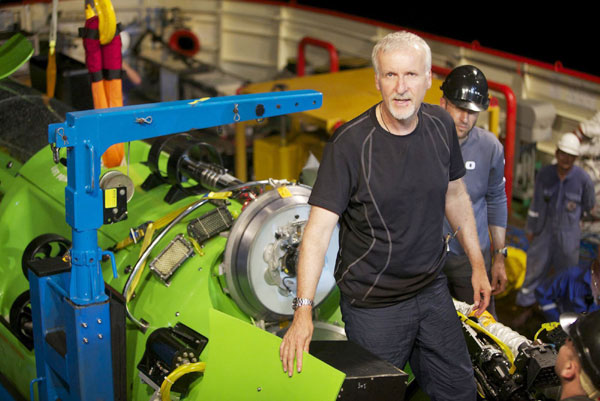Cameron goes to Earth's deepest point
 |
|
Explorer and "Titanic" filmmaker James Cameron emerges from the hatch of Deepsea Challenger during the testing of the submersible in Jervis Bay, south of Sydney, March 25, 2012.[Photo/Agencies] |
Hollywood icon James Cameron has completed his journey to Earth's deepest point.
The director of "Titanic," ''Avatar" and other films used a specially designed submarine to dive nearly seven miles. He spent time exploring and filming the Mariana Trench, about 200 miles southwest of the Pacific island of Guam, according to members of the National Geographic expedition.
Cameron returned to the surface of the Pacific Ocean on Monday morning local time, Sunday evening on the U.S. East Coast, according to Stephanie Montgomery of the National Geographic Society.
He reached a depth of 35,756 feet and stayed on the bottom for about three hours before he began his return to the surface, according to information provided by the expedition team. He had planned to spend up to six hours on the sea floor.
"Cameron collected samples for research in marine biology, microbiology, astrobiology, marine geology and geophysics," the Geographic said.
The trip to the deepest point took two hours and 36 minutes. But Cameron's return aboard his 12-ton, lime-green sub called Deepsea Challenger was a "faster-than-expected 70-minute ascent," according to National Geographic. A helicopter spotted the submersible bobbing in the water and it was brought aboard the ship by a crane.
There were no immediate reports regarding Cameron's well-being. A medical team was present when Cameron, 57, emerged from the sub, according to the expedition.
Expedition physician Joe MacInnis told National Geographic News before the journey that recent test dives, including one that went more than five miles deep, had gone well and that he expected Cameron would be fine.
"Jim is going to be a little bit stiff and sore from the cramped position, but he's in really good shape for his age, so I don't expect any problems at all," said MacInnis, a long-time Cameron friend, according to National Geographic.
Cameron also captured still photographs and video, but there was no immediate word on when the images will be released. The Geographic said the expedition is being chronicled for a 3-D feature film for theatrical release and subsequent TV broadcast.
"There is scientific value in getting stereo images because ... you can determine the scale and distance of objects from stereo pairs that you can't from 2-D images," Cameron told the Geographic before the dive.
The scale of the trench is hard to grasp - it's 120 times larger than the Grand Canyon and more than a mile deeper than Qomolangma is tall.
"It's really the first time that human eyes have had an opportunity to gaze upon what is a very alien landscape," said Terry Garcia, the National Geographic Society's executive VP for mission programs, via phone from Scotland.
Among the 2.5-story-tall sub's tools were a sediment sampler, a robotic claw, a "slurp gun" for sucking up small seacreatures for study at the surface, and temperature, salinity, and pressure gauges.
Swiss engineer Jacques Piccard and Don Walsh, a U.S. Navy captain, are the only others to reach the spot. They spent about 20 minutes there during their 1960 dive but couldn't see much after their sub kicked up sand from the sea floor.
One of the risks of a dive so deep was extreme water pressure. At 6.8 miles below the surface, the pressure is the equivalent of three SUVs sitting on your toe.
Cameron told The Associated Press in an interview after a 5.1 mile-deep practice run near Papua New Guinea earlier this month that the pressure "is in the back of your mind." The submarine would implode in an instant if it leaked, he said.
But while he was a little apprehensive beforehand, he wasn't scared or nervous while underwater.
"When you are actually on the dive you have to trust the engineering was done right," he said.
The film director has been an oceanography enthusiast since childhood and has made 72 deep-sea submersible dives. Thirty-three of those dives have been to the wreckage of the Titanic, the subject of his 1997 hit film, which is being released in a 3-D version next month.


















